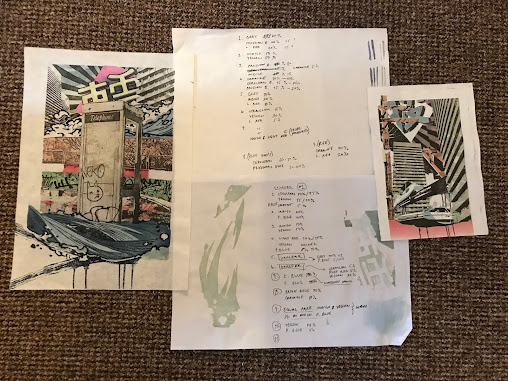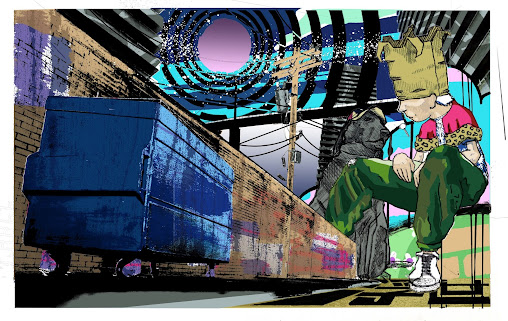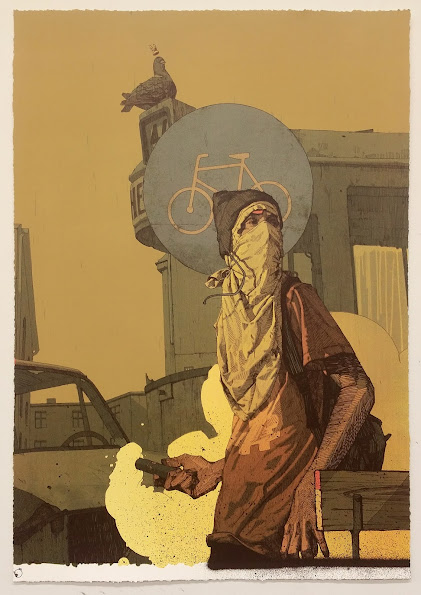The Figure
The figure in the A2 print was ultimately most likely what I spent most of my time on, upsetting then that in the end I decided to cut him from the Image entirely...
"Though I do not want, to live on in this floating world.
Let me remember one thing, this midnight and this moonrise."
This waka poem was the one I chose to inspire this series of works. It gave me an avenue into describing the times of day in the 'floating world', a concept I've already mentioned can be personally adapted to fit the setting of whoever is creating it.
With this in mind I started to imagine 'my floating world'
This was where I started but was somewhat lost for where to go next, I intended it to be A2 and so struggled with building up layers on a computer screen, not knowing whether or not that section would scan well when blown up to full size.
My solution to this was print it of at a large size and then lay over transparencies and build layers that way, as I would for a print at a more manageable size.
This helped somewhat but not hugely, I usually resort to this only when my keyblock is complete, I then use transparencies to build up colour sections. This was a bit different, I used rice paper to start slowly penciling in where I though I might want all the elements to sit. Eventually I scrapped this, it helped me get down where to place a figure and the telegraph lines for the Utility Pole, the greatest triumph of this method was the formation of the grassy node that is in the final versions bottom left corner and in the A4 print too.
These drips became the outline for the grassy node and were used in every print of the series, so the above mentioned method wasn't a waste, something pretty crucial came from it..
It also gave me the idea to build up the colour in the wall in the exact same way, only smaller. I could print the image of the lone wall off on A4 and build it's colour blocks similarly.
At this stage I wanted to start trying to bring the figure in, I wanted him there not only because the poem that inspired the series is clearly written in the first person by someone inhibiting the floating world but also because I wanted something more concrete than just the image to tell the viewer that what they were looking at was a world apart from our own as was suggested originally in ukiyoe by the term floating world.
I first drew the figure from an image that wasn't mine, an artist in a previous post had drawn it but I was and have been fascinated by the drawing for years so drew him from the originally as I suspected it would tell me if this were to work or not.
The figure here is as I mentioned before the original work of street artist Sainer. The dog in a propeller cap was a touch of my own, it felt right.
To begin with I was really happy with how the figure looked I kept him at true to life scale, as these were miniatures in the pictures and not actual dumpsters/Utility poles. I liked this it felt like it worked.
I knew if I wanted to keep him though I would require to change the figure to one of my own making but thought I would move on to the sky first to get the base image created.
The skies in these images were all made in Authorship, very helpful really, I spent a lot of time during Authorship making custom sky patterns, which I only really used one or two of in the end, they came in very helpful here.
However the skies were a little scrappy and hastily made so once I had decided on which sky patterns I wanted to use I remade them with a brand new set of opaques, just to ensure the quality of them.
As I started doing this I did suspect I may be pissing about and wasting time I didn't have... This really wasn't the case.
Each of these is a set of opaques I remade from the previous unit for this one. I now have all of these properly filed in a system that allows me to use and reuse them in future prints, this was the first time such a filing system had dawned on me and I've now started keeping all types of cuttings, clippings and transparencies, for future use.
Now to redo the figure....
This is quite honestly only a small handful of what must have been hundreds of versions of this figure, I obsessively drew him over and over again only to get more and more annoyed at my clear lack of understanding to figure drawing, I found this incredibly frustrating as only a few years ago figurative work was what I would've prided myself in, so this was a real downer.
here's some more....
Too many really!
In the end I never used King Trash as I came to call him, I eventually landed on a drawing I was really quite happy with...
He was certainly my own now and I was happy with the drawing, inspired both by the drawing by sainer and original illustrations of the Mad Hatter from Lewis Carrolls Alice In Wonderland.
I finally liked the drawing. However, after working for several days to try and get him feeling at home in the rest of the image I realised this was going to be even more of a monumental task than drawing him was.
With the rest of the image being so Highly detailed, due to the use of photography, I couldn't find the right way integrate him. The line drawing I had done fit nicely in the frame but I had to strip back the line drawing in order for the keyblock to be printable (engravers can only do so much), this meant that his detail would have to come from colour build up.
I finalised him with a a range of colours and realised that as he had caused me to add at least 5 new colour blocks to bring me to a total of 22 at the time, he wasn't going to make the cut.
I spent time thinking about another way to integrate him and realised that whichever method I chose it would likely be far easier, safer and quicker to just replace him altogether. A shame but had to be done, I do have the drawing filed for the future though, so King Trash may yet see the process of print.
Back Up Work
Grassy bump
'Floating World'
Sky Studies
All of this brought me up to here...
It's almost ready to take to print just a couple more additions and it should be good. 17 layers, it will be a challenge to print but looking forward to it.

















































